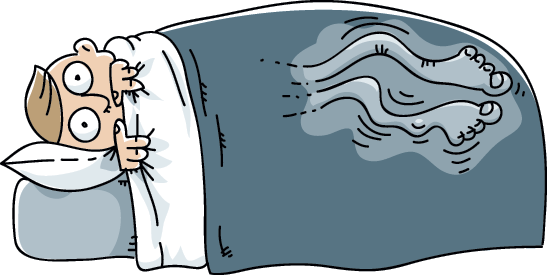Page Contents
- 1 WHAT IS IT?
- 2 WHAT CAUSES IT?
- 3 WHY IS IT A PROBLEM?
- 4 WHAT MAKES US SUSPECT IT?
- 5 HOW DO WE CONFIRM A DIAGNOSIS?
- 6 HOW DO WE RULE OTHER DIAGNOSES OUT?
- 7 HOW DO WE TREAT IT?
- 8 HOW WELL DO THE PATIENTS DO?
- 9 WAS THERE A WAY TO PREVENT IT?
- 10 WHAT ELSE ARE WE WORRIED ABOUT?
- 11 OTHER HY FACTS?
- 12 ARCHIVE OF STANDARDIZED EXAM QUESTIONS
- 13 FURTHER READING
WHAT IS IT?
Restless legs syndrome (RLS) is a movement disorder that (exactly as it sounds) is characterized by disagreeable leg sensations that occur prior to the onset of sleep.

WHAT CAUSES IT?
The exact etiology is not completely clear, however it is believed that RLS can be caused by metabolic disorders such as:
- Chronic alcohol use
- Uremia
- Iron deficiency/iron deficiency anemia
WHY IS IT A PROBLEM?
While not life threatening, this condition can dramatically lower the quality of sleep in the affected individual.
WHAT MAKES US SUSPECT IT?
Risk factors
Family history (seems to have autosomal pattern of inheritance).
Initial Presentation
Common Chief Complaints:
- Difficulty sleeping that is caused by uncomfortable leg sensations right before bed.
- Periodic limb movement (i.e. twitching) that occurs at night
Important points in history:
- Sensory discomfort felt in legs
- Worsens at rest/at night when patient is trying to sleep.
- Received by movement
Physical Exam Findings
No clear physical exam findings for this condition.
HOW DO WE CONFIRM A DIAGNOSIS?
Diagnosis is often made from the patient history (in the absence of other findings.
HOW DO WE RULE OTHER DIAGNOSES OUT?
Neurological examination should not show any focal neurological defects/areas of sensory loss/motor weakness.
HOW DO WE TREAT IT?
Dopamine/dopamine agonists:
- Ropinirole
- Pramipexole
- Levodopa can be used (but tolerance develops)
Benzodiazepines:
- Clonazepam
Gabapentin can be used as well.
HOW WELL DO THE PATIENTS DO?
This is not a life threatening condition, however if left untreated, can very much affect the quality of sleep the patient receives.
WAS THERE A WAY TO PREVENT IT?
N/A
WHAT ELSE ARE WE WORRIED ABOUT?
Treating the underlying cause of RLS: let us keep in mind that often RLS might occur secondary to the processes listed below. As a result we must not only manage the symptoms of the RLS but also search (and address) the possible underlying causeless for this presentation.
- Chronic alcohol use
- Uremia
- Iron deficiency/iron deficiency anemia
Periodic limb movement disorders are very common in patients with RLS. These are often characterized by periodic leg twitches during the night.
OTHER HY FACTS?
Ekbom syndrome is also another name for RLS
ARCHIVE OF STANDARDIZED EXAM QUESTIONS
This archive compiles standardized exam questions that relate to this topic.
FURTHER READING
Page Updated: 07.17.2016